There’s so much more to breads in Indian cuisine, than just the well-known flatbreads. For instance, take this Pav, which is also popular under the sobriquet Ladi Pav and is a specialty from the ‘city of dreams,’ Mumbai in Maharashtra. While there’s more to read about this Mumbai style bun in the post, I’m also sharing a step-by-step Pav Recipe for you to easily follow and make this soft, fluffy and light bread at home. The ingredients are not much but the procedure is quite long. So, make sure to follow the recipe well to get the best result.
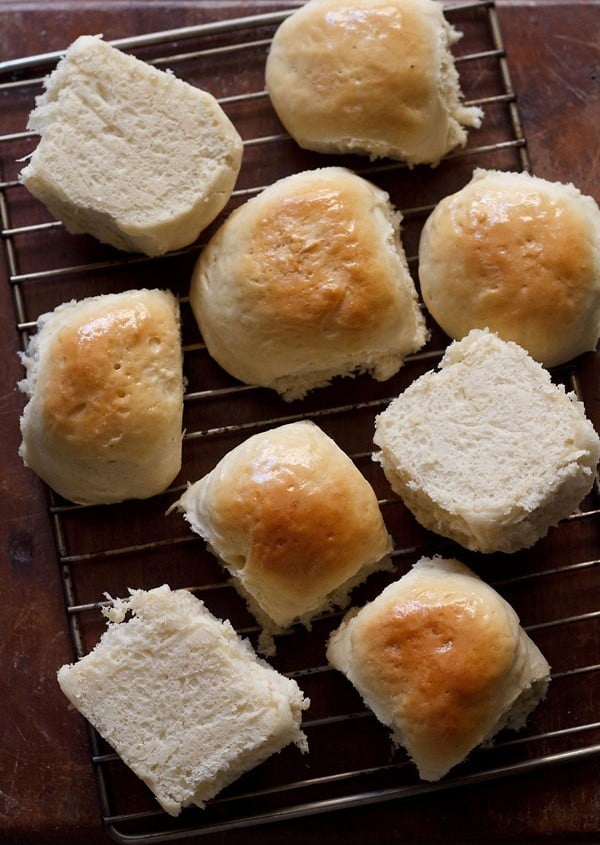
About Pav Recipe
Pav is basically a small loaf of bread, introduced by the Portuguese in India. Thus, also referred to as ‘pao,’ going by the Portuguese food traditions.
In Hindi, the word Pav refers to ‘quarter or ¼ᵗʰ .’ Sometimes you get the Ladi Pav in a set of 4. It is also said that since the bakers kneaded the dough with their feet at that time, the name is Pav which means ‘feet’ in Hindi.
Commercially, Pav is always made with maida or all-purpose flour. However, at home, we can make these small bread rolls with whole wheat flour (atta) or other flours. I also make a Pav Recipe with 100% whole wheat flour.
You could opt to make Pav with equal portions of both all-purpose flour and whole wheat flour. Pav made this way using an equal mix of both the flours also yields a soft and light texture.
The recipe of Mumbai Ladi Pav in this post is made with 100% all-purpose flour (maida). I make these light bread rolls once in a while or on demand, when the regular Whole Wheat Bread or chapatis get monotonous for the family.
I have developed this Pav Recipe over a period of time to get the best result. The recipe method makes use of the sponge or ‘poolish’ method for leavening, resulting in super soft and spongy Pav.
I have added instant yeast in the recipe. However, fresh yeast or dry active yeast can also be used. To get the aroma and taste like that of the Ladi Pav made in the bakeries, it is advisable to use fresh yeast. The proportions of all 3 are mentioned in the recipe card below.
Usually, I make these Mumbai style buns or dinner rolls to be served with Pav Bhaji, Misal Pav, Masala Pav, Vada Pav, samosa pav or pav sandwich. I never buy Pav from outside as this recipe really yields in excellent homemade bread rolls.
How to make Pav
Make Dough
1. In a bowl take, 1 cup all-purpose flour, 1 teaspoon instant yeast (rapid rise yeast) and 2 teaspoons sugar.
Make sure the water is lukewarm. If not then all your efforts will go waste. The water should not be hot.
Note: If using active dry yeast or fresh yeast, then ensure the water is neither hot nor cool. Hot water will destroy the yeast and less warm water or cool water won’t help in activating the yeast.
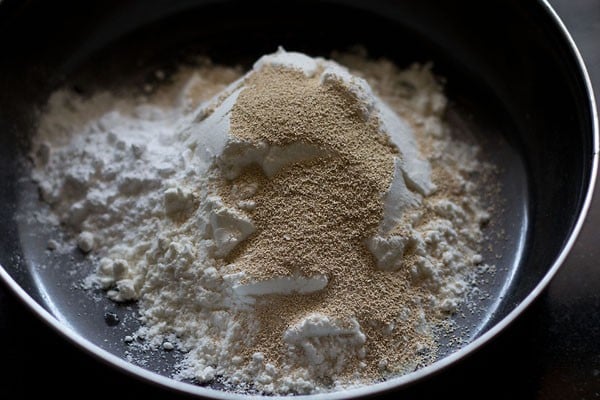
2. Add 1 cup lukewarm water.
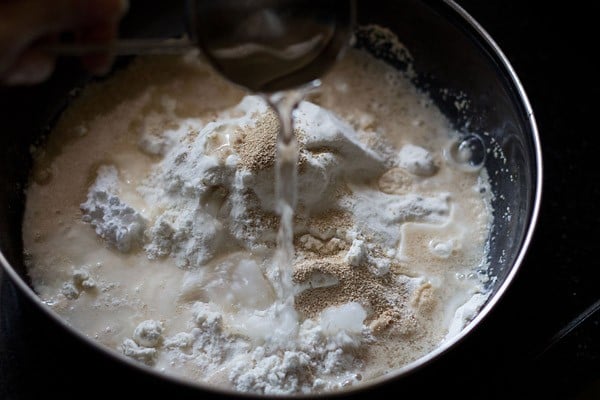
3. Stir or whisk to make a smooth and thick batter without any lumps.
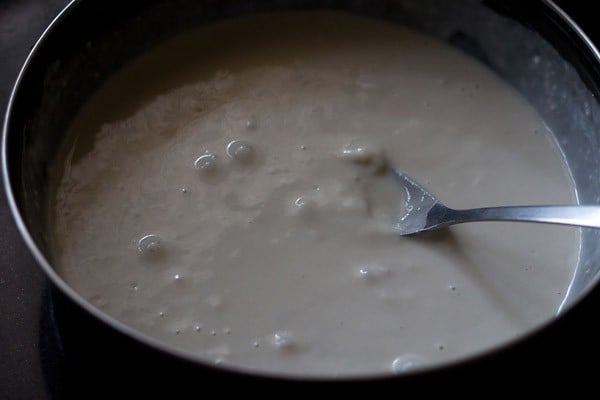
4. Cover and keep the bowl for 30 to 40 minutes or till you see a bubbly and frothy mixture. The batter would also have risen.
The picture below shows the consistency. This is the sponge starter.
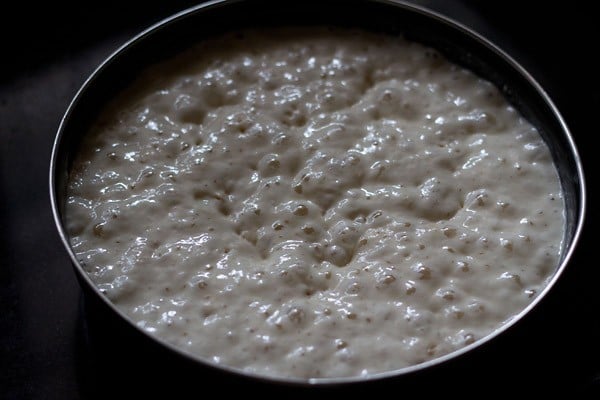
5. Add 2 tablespoons oil, 1 teaspoon salt and 1 cup all-purpose flour.
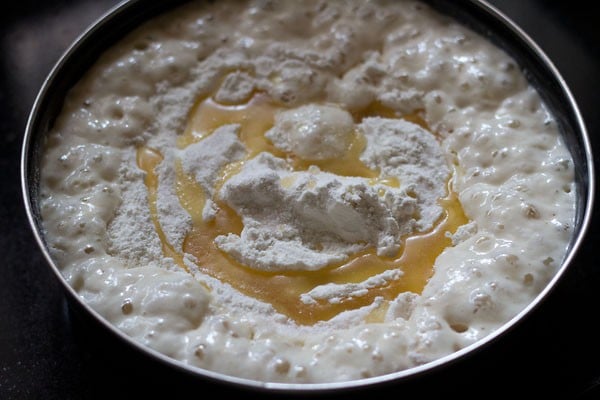
6. Mix with a spoon or spatula.
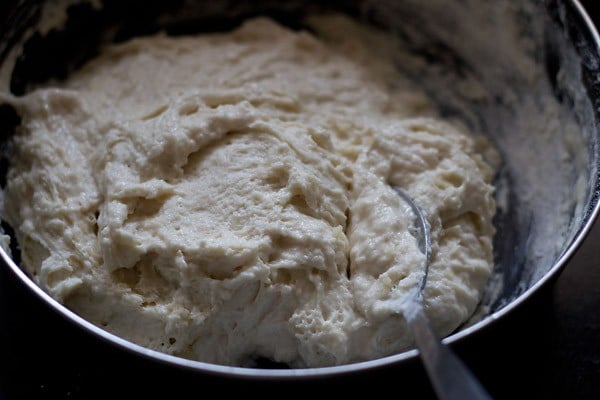
7. Add 1.25 cups of all-purpose flour.
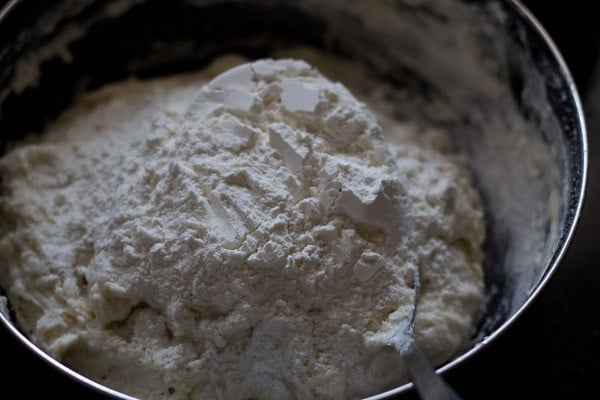
8. Mix and then begin to knead for about 10 to 12 minutes. If the dough appears sticky, then you can add about ¼ to ½ cup flour.
The proportion of water to be added depends on the quality of the flour. Overall, I added 3.25 cups flour and 1 cup water.
You can also knead the dough using a stand-mixer bowl attached to a dough hook.
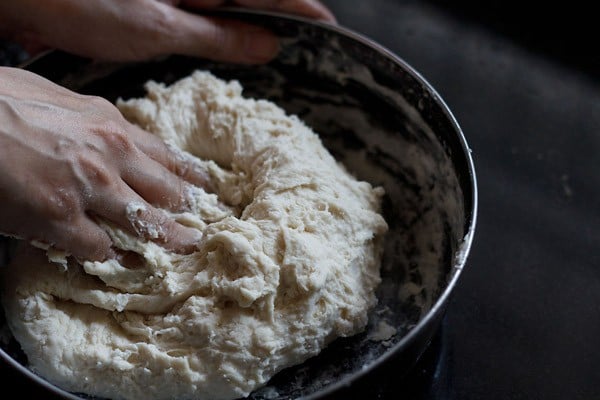
9. Knead to a smooth, pliable, soft and elastic dough. The dough on stretching should not break or tear.
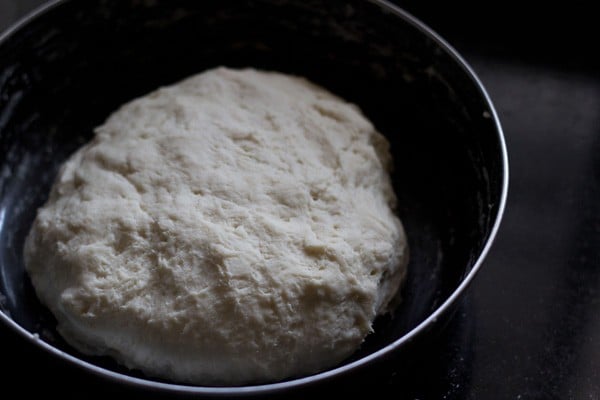
Leaven Dough
10. Spread oil or butter all over the dough. Cover the bowl with a kitchen cotton napkin or a lid and keep the bread to leaven for 20 to 25 minutes.
The leavening time depends on the type of yeast used and the temperature conditions.
- For instant yeast, 20 to 25 minutes of the first rise is enough.
- For dry active yeast or fresh yeast, you will have to keep for about 45 minutes to 1 hour or more.
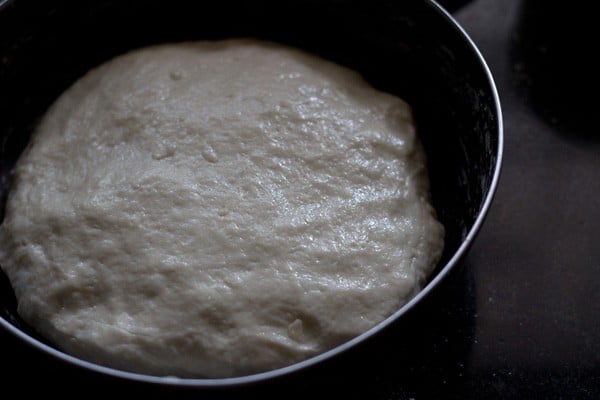
11. The risen and doubled dough for Pav.
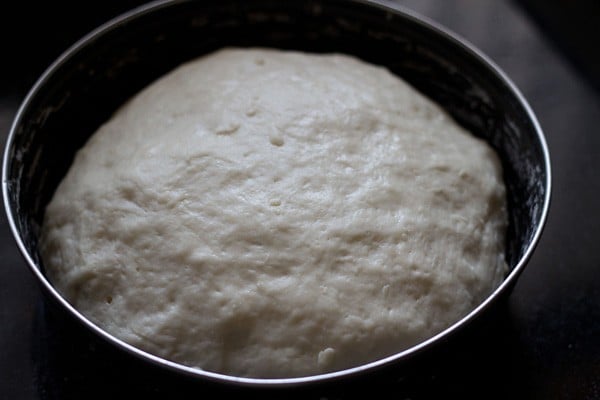
12. Gently punch and deflate the dough and form a log.
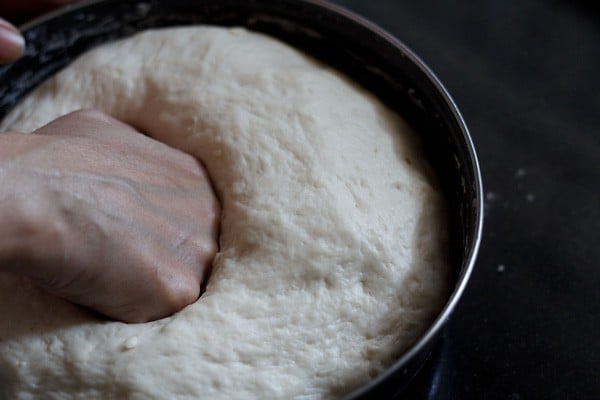
13. Slice the log into equal portions.
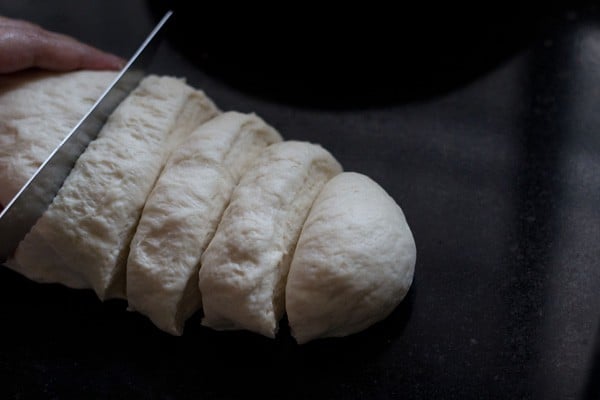
14. Take each portion and roll between your palms to get a smooth round roll.
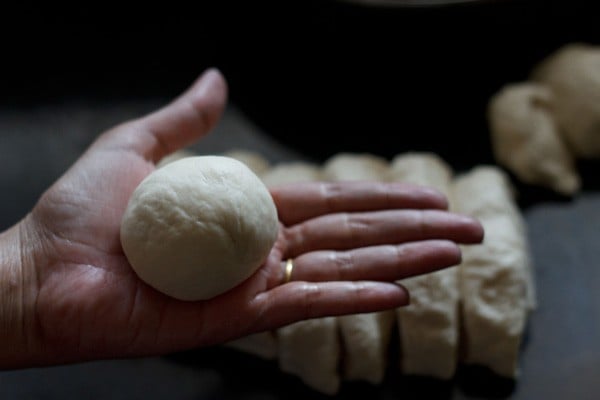
Bake Pav
15. Make rolls this way and place them in a greased baking tray keeping 1 inch space between each. Cover and keep for 25 to 30 minutes for the second rise. The small buns would increase in size.
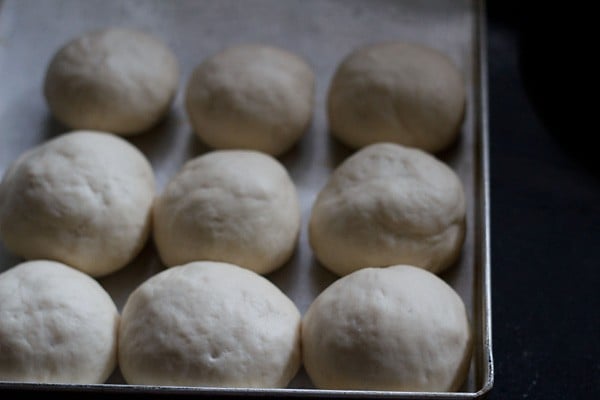
16. Then, brush the rolls with some milk. This gives a golden color to the Ladi Pav.
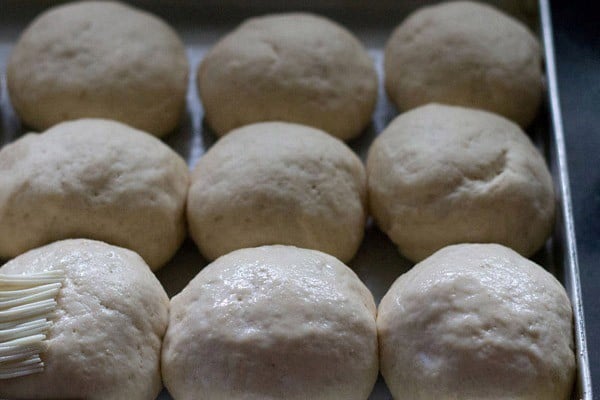
17. Place the baking tray in a preheated oven at 200° C/ 390° F for 25 to 30 minutes or till the tops turn golden and the rolls sound hollow on tapping.
Before baking, remember to preheat oven at for 200° C/ 390° F 15 minutes.
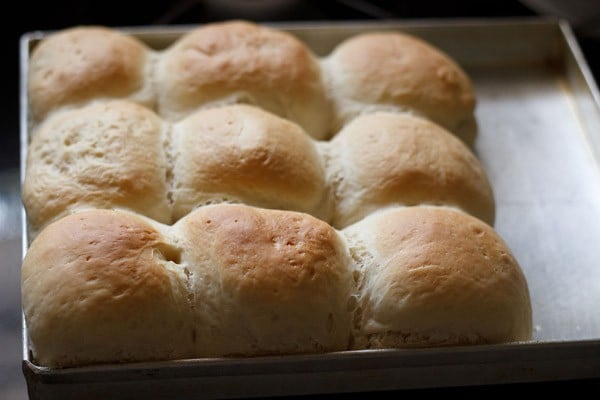
18. Remove the baked rolls from the tray (with a spatula) and place on a wired rack or wired tray, so that they don’t become softened and moist from the bottom due to heat condensation.
Brush melted butter or spread softened butter on top of the Pav for a glaze. This is an optional step.
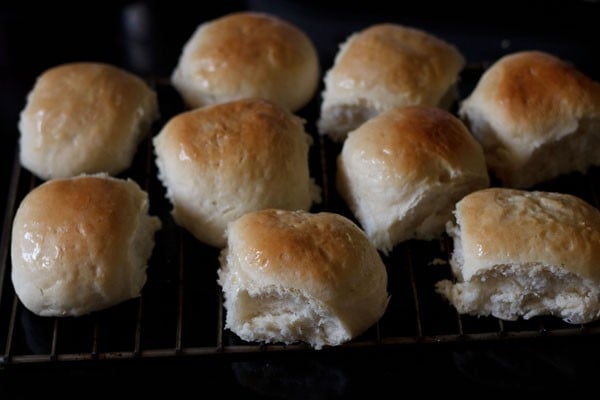
19. Serve Pav warm or at room temperature with any curry like Usal, a vegetable dish or just as plain Maska Pav (buttered rolls) with Masala Chai or Cutting Chai.
You can also use them to make Mumbai street food snacks like pav bhaji, misal pav, vada pav or Kacchi Dabeli.
Leftover Pav keeps well for about a week in the fridge and a few weeks in the freezer.
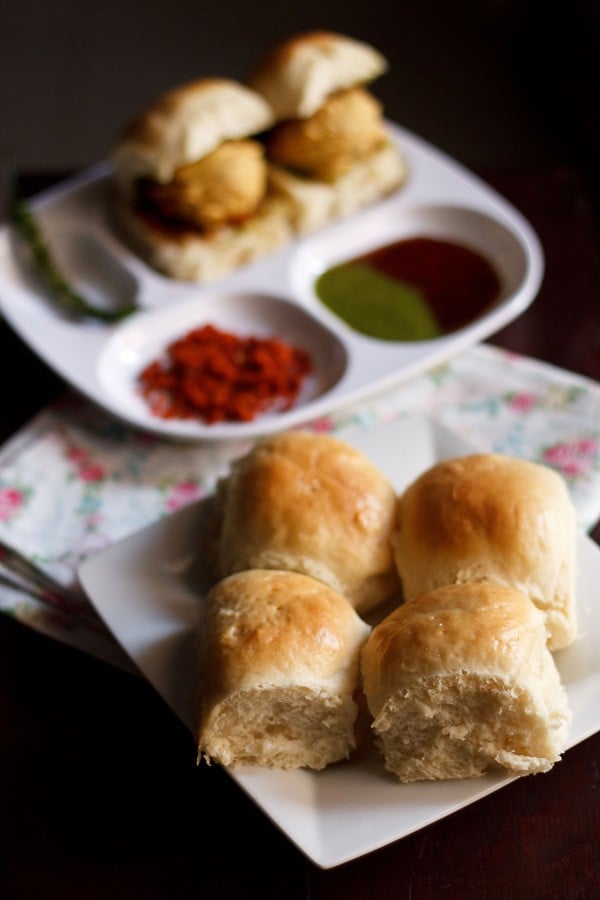
Expert Tips
- If you can source, then try making pav with unbleached all-purpose flour. You can also make these fluffy dinner rolls with bread flour.
- The quantity of water to be added depends on the quality of flour. If the dough become sticky, then add some flour and if the dough looks dry, then add some water.
- Instead of kneading with hands, you can also knead the dough in a food processor or in an electric mixer with a dough hook.
- If the top surface of the buns browns quickly, then place aluminium foil or parchment paper on the top. This will avoid further browning.
- The leavening time depends on the type of yeast used and the temperature conditions. For instant and fresh yeast, keep for 20 to 25 minutes for the first rise. For dry active yeast, you will have to keep for about 45 minutes to 1 hour or more.
- Brushing the pav bread rolls with some milk gives a nice golden color to them on baking. You can brush the baked buns with melted butter too for a glaze.
- Once the Ladi Pav bread is baked, remove them from the tray and place on a wired rack so that they don’t soften or moisten from the bottom due to heat condensation.
More Bread Recipes To Try!
Bread Recipes
Bread Recipes
Bread Recipes
Bread Recipes
Please be sure to rate the recipe in the recipe card or leave a comment below if you have made it. For more vegetarian inspirations, Sign Up for my emails or follow me on Instagram, Youtube, Facebook, Pinterest or Twitter.
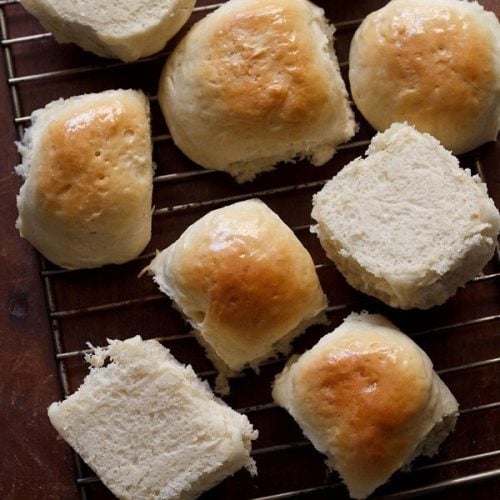
Pav Recipe | Ladi Pav | Pav Bread
Ingredients
- 3.25 to 3.5 cups all-purpose flour (maida) – I added 3.25 cups flour
- 2 tablespoons oil or softened butter, use any neutral flavored oil
- 1 teaspoon instant yeast or 1.5 teaspoon dry active yeast or 1 tablespoon fresh yeast
- 2 teaspoons sugar
- 1 teaspoon salt or add as required
- 1 cup water – lukewarm, do add water if needed later
- 1 to 2 tablespoons milk – for brushing, optional
- 1 to 2 tablespoons butter – melted, for brushing on pav bread
Instructions
Making dough
- In a bowl take 1 cup of all-purpose flour, instant yeast and sugar.
- Add 1 cup lukewarm water. Stir or whisk to make a smooth thick batter without any lumps.
- Cover and keep the bowl for 30 to 40 minutes till you see a bubbly and frothy layer on the top. The batter would also have risen.
- Add oil, salt and 1 cup flour. Mix with a spoon or spatula.
- Next add 1.25 cup flour. Mix again and then begin to knead for about 10 to 12 minutes.
- If the dough appears sticky then you can about ¼ cup flour more or as needed. The proportion of water to be added, depends on the quality of the flour. I added 3.25 cups flour for 1 cup of lukewarm water.
- Knead very well to a smooth, soft, supple and elastic dough.
- Place dough in a bowl. Spread oil or softened butter all over the dough.
Leavening pav dough
- Cover the bowl with a lid or a kitchen cotton napkin and keep the bread to leaven for 20 to 25 minutes.
- Once the pav dough has risen and doubled, then gently punch and deflate the dough and form a neat log.
- Cut the log into equal sizes. Take each portion and roll between your palms to get a smooth round roll.
- Make rolls this way and place them in a greased tray keeping 1 inch space between all of them.
- Cover and allow the second rise for 25 to 30 minutes. The small buns would increase in size.
Baking ladi pav
- Just before 15 minutes you bake the pav, preheat the oven at 200° C/ 390° F.For a regular oven, heat both the top and bottom elements. For a microwave oven with convection mode, preheat for 15 minutes at 180° C/356° F.
- Then brush the pav buns with some milk. This gives a golden color to laadi pav.
- Place the baking tray in the center rack in a preheated oven at 200° C/ 390° F for 25 to 30 mins or till the tops turn golden and the pavs sound hollow on tapping. For baking in the microwave oven at convection mode, bake at 180° C/356° F.
- Remove them from the tray (with a spatula) and place on a wired rack or wired tray, so that they don't become softened and moist from the bottom due to heat condensation.
- Brush melted butter or spread softened butter on top of the pavs. This is an optional step.
- Serve the Pav warm or at room temperature with any curry, vegetable dish or just as plain bun maska pav (buttered rolls) served with masala chai.
- Pav can be stored in the refrigerator for about a week. Keep them in air-tight a container or a bread box.
Notes
- If the dough become sticky then add some flour and if the dough looks dry, then add some water.
- If the top surface of the bread browns quickly than place aluminum foil or parchement paper on the top. This will avoid further browning.
- Instead of kneading with hands, you can also knead the dough in a food processor or in an stand mixer with a dough hook.
- The leavening time depends on the type of yeast used. For instant and fresh yeast, 20 to 25 minutes of the first rise is enough. For dry active yeast, you will have to keep for about 45 minutes to 1 hour or more.
- If possible use unbleached all-purpose flour. You can also make pav with bread flour.
- Pav recipe can be easily halved, doubled or tripled.
Nutrition Info (Approximate Values)
This Pav Recipe from the archives first published in October 2014 has been updated and republished on January 2023.
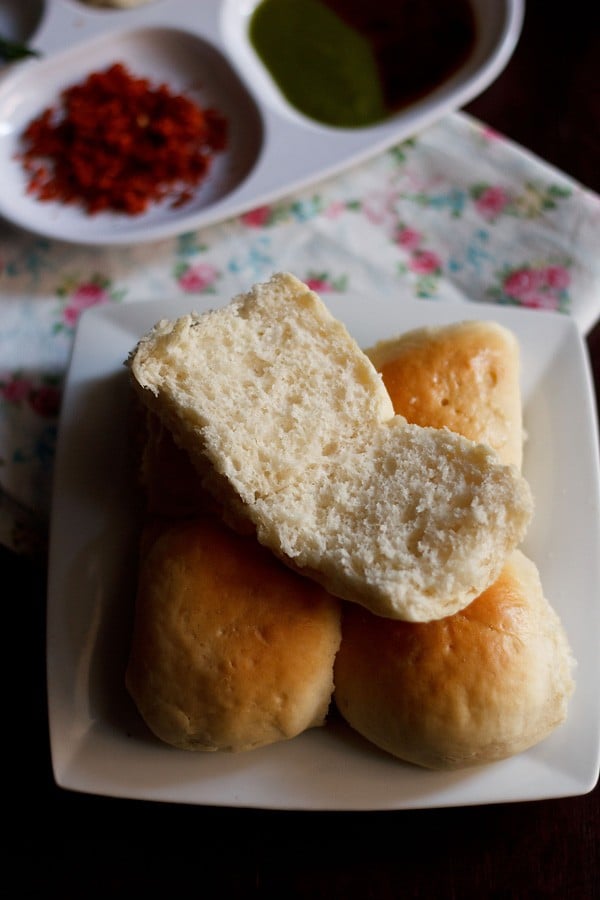
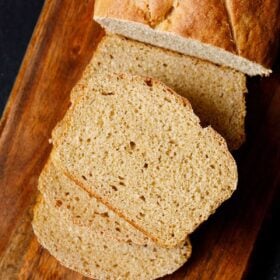
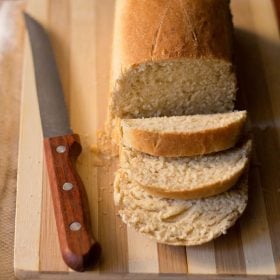
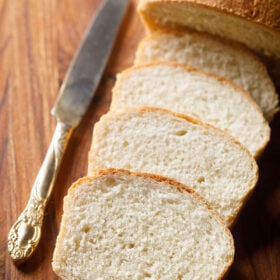
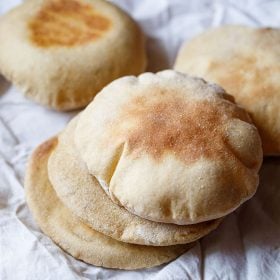
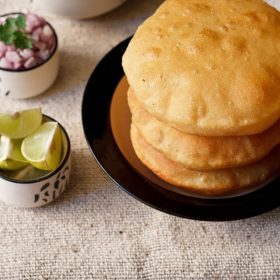
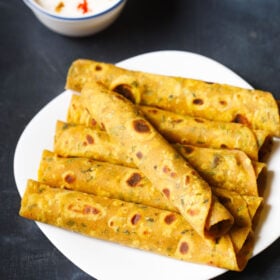
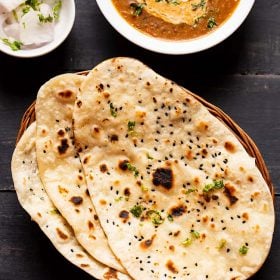
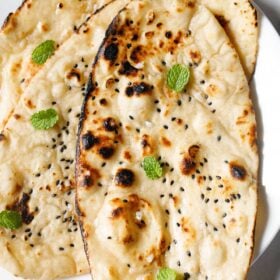








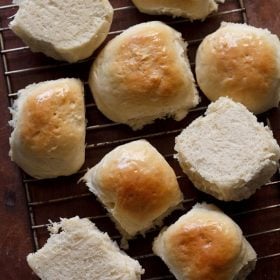
Can you use bread flour for this?
you can use bread flour.
Today m making ur wheat bread recipe n pauv recipe…. I have tried ur many dishes I really like ur recipes …. Whenever I want to cook something I see ur blog first thank u
quite pleased to know this heena thankyou for your kind and positive words. surely try wheat bread and keep us posted how it was? and you are welcome.
Super spongy!!! Just tat the top portion of pav was not that Golden… Rest it tastes really good 🙂
thank you. if you bake for some more minutes, the top will become golden.
Hi Dassana,
I am a huge fan of your website and have been following your recipes on a daily basis from dals to veggies to pulao. for everything i refer your blog once.
i want advice from you on some great bread baking books.
i am trying my hands on baking and would like to refer to some books as well in this regard.
thanks and keep up the good work.
you are an inspiration to a lot of women
thank you urvashi. peter reinhart’s books are good on bread baking. then there is also the bread bible which is a good book. i have artisan breads everyday by peter reinhart and its a really good book.
Hi Dassana,
I tried the Pav today. The crust was a bit hard. Where did I go wrong???
Thank you for the recipe. ?
the crust becomes hard, when the baking time is more or if the heating is too much in the oven. if you use OTG, then keep the tray in the center of the oven and keep both the top and bottom heating elements on.
Thanks
Will prepare pav. Recipe seems to be perfect.
What it means ‘yr comment is waiting moderation’
means that the comment is manually approved.
surely Fatima do try the pav recipe and let us know and thankyou 🙂
I don hav 250ml cup. Mine is 240ml cup. Can i use it?
yes you can use 240 ml cup.
These look so delicious! Love your recipes! The orange is our fav :)) I had one question though- how many days do they stay well? I m planning to make these for a party so wanted to know if they could be made ahead of time!
Thanks for the wonderful recipes!
welcome manasi. they stay good for 3-4 days in fridge.
hi dassana,
I can’t thank you enough for this amazing recipe. After years of failing at trying out a perfect pav recipe, my loaf finally turned out to be perfect. My family loved it!
I followed your instructions to the T, except that i added half a tsp of baking powder. Also i use a convection oven so i preheated the oven to 200 degrees and baked the pavs for 10 mins. After that i raised the temperature to 250 degrees and baked for another 15 mins to get a brown surface.That’s it. It came out amazingly perfect. I am gonna note down this recipe forever. Thank you so very much! 🙂 🙂
welcome harshree. glad to know that the recipe worked perfectly for you. thanks for sharing your experience.
thanks a lot harshree for this positive feedback. co incidentally i also made pav today with both atta/whole wheat flour and some maida, but in pressure cooker. thanks also for sharing the oven tips you have mentioned. will help readers too.
Hi harshsree,
Why did you add baking powder? Does it help in making the paavs more soft?
Regards
Hi dassana,
How can I substitute yeast in any recipe.
What will be tthe proportion.
yeast can be substituted but the recipe will change completely.
Hi sir
I regularly follow your recipes. They r really good. thanks for the pictorial representation.
bake recipes – shall we bake in a non electric oven, pls let me know.
thanks. what is a non electric oven. do you mean gas oven?
Hi I tried your pav recipe which came out well texture and look wise but I felt it was little hard not as soft as we get outside.what mistake I would have done please tell do that next time I can make it better.
most often denseness or hardness is due to the incorrect proofing of yeast or not a good quality of yeast. try to use a good quality of yeast. also knead the dough very well.
Hi Dassana,I followed the pav recipe as closely as I could..but I guess I went wrong somewhere. The pav cracked on all sides..was a bit dense and smelled n tasted of yeast.your kind advise on this.
hi tanvi. i thinks its due to the quality of yeast and also that the yeast has not proofed properly. that why the denseness and cracking.
I firstly want to say that your receips are the best I always keep trying your receips and get good appreciation. I had also tried this receipe and came out very gud I just wanted to ask that my pav had that yeasty smell. I liked it ,but my kids have problem can you help me out by stating a remedy for reducing his yeasty smell in my pav. Thank you
thanks. yeasty smell could be due to the quality of yeast. you can reduce the yeast by 1/4 or 1/2 tsp in the recipe.
Hi Dassana,
pls tell me if I want to make this pav with 100% wheat flour then i hv to follow same method n amt of ingredient ?
asha, it will become dense. check this recipe where 50-50 of maida and atta is added – https://www.vegrecipesofindia.com/pav-recipe-indian-pav/